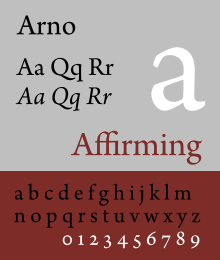Arno (typeface)
 | |
| Category | Serif |
|---|---|
| Classification | Old-style |
| Designer(s) | Robert Slimbach |
| Foundry | Adobe Type |
| Date released | 2007[1][2] |
Arno, or Arno Pro, is a serif type family created by Robert Slimbach at Adobe intended for professional use.[3] The name refers to the river that runs through Florence, a centre of the Italian Renaissance. Arno is an old-style serif font, drawing inspiration from a variety of 15th and 16th century typefaces.[4] Slimbach has described the design as a combination of the period's Aldine and Venetian styles, with italics inspired by the calligraphy and printing of Ludovico degli Arrighi.[5]
Arno was released in five optical sizes: separate fonts for different text sizes from captions to headings. In addition, Arno contains alternate letter styles such as swash italics inspired by Renaissance calligraphy. Other supported OpenType features include proportional and tabular numbers, old style figures, subscripts and superscripts, and ordinals.[5][6]
One of the most complete serif font families ever designed, Arno supports Adobe CE, Adobe Western 2, Cyrillic, mono- and polytonic Greek, Latin Extended and Vietnamese character sets with small caps, as well as dingbat and fleuron characters inspired by early printing.
Availability
Part of the Adobe Originals programme, Arno is included with Adobe Creative Suite 3, Adobe Font Folio 11 and Adobe Typekit.
Inspiration
The font family is a multi-purpose type suitable for book design, inspired by the calligraphically-inspired humanistic types of the Italian Renaissance. Slimbach described his goal as giving it "a tangible style" to be "as readable as possible".[5]
Reception
Arno has received positive reviews. Reviewing the font for Typographica, designer Mark Simonson described it as "nicely sturdy" for body text and highlighted the sophistication of its italic alternate programming, noting that when enabled Arno "almost becomes a different typeface".[6] Font expert Stephen Coles compared it to Requiem.[7] Designer and calligrapher Paul Shaw suggested that its design represents a different, more "lively" approach to the neutral-looking Minion, and "yet not as loose and carefree as Brioso."[8]
In 2011, the American Chemical Society began using Arno Pro for the body text of several of its journals, including the flagship Journal of the American Chemical Society after decades of using Times Roman.[9]
Optical sizes
| Optical sizes | Caption | Small Text | Regular | Subhead | Display |
|---|---|---|---|---|---|
| Intended point sizes | <8.4 | 8.5–10.9 | 11–13.9 | 14–21.4 | >21.5 |
| Weights (all with italics) | Regular, semi-bold, bold | Regular, semi-bold, bold | Regular, semi-bold, bold | Regular, semi-bold, bold | Light, regular, semi-bold, bold |
A light weight is included only in the display style. Slimbach commented that he felt that using light styles at text sizes would be a mistake because they would be hard to read.[5][7]
Awards
It was a winning entry in the Type Directors Club 2007 Type Design Competition (TDC2), under the Type System / Superfamily category.[10]
Document design expert Matthew Butterick used Arno in the print edition of his book Typography for Lawyers.[11]
References
- ^ "Identifont". Retrieved 2009-10-01.
- ^ "Typedia". Media Temple. Archived from the original on 2009-09-28. Retrieved 2009-10-01.
- ^ Adobe Fonts : Arno
- ^ Phinney, Thomas. "Arno Pro, a new Slimbach typeface". Typekit blog. Adobe. Retrieved 14 August 2015.
- ^ a b c d Twardoch, Slimbach; Sousa, Slye (2007). Arno Pro (PDF). San Jose: Adobe Systems. Archived from the original (PDF) on 30 August 2014. Retrieved 14 August 2015.
- ^ a b Simonson, Mark. "Arno review". Typographica. Retrieved 14 August 2015.
- ^ a b Coles; et al. "Comments on typophile thread". Typophile. Archived from the original on January 23, 2015. Retrieved 14 August 2015.
- ^ Shaw, Paul (June 2008). "Arno review". Print magazine.
- ^ For the Journal of the American Chemical Society, the change in font, along with numerous other formatting changes, took place between the 3rd and 4th issues of 2011 (vol. 133): J. Am. Chem. Soc. 2011, 133, 643.
- ^ "Type Directors Club : News : TDC2 2007 Results". Type Directors Club. 2007. Archived from the original on 12 January 2008. Retrieved 2008-02-17.
- ^ Kupferschmid, Indra (5 July 2011). "Typography for Lawyers". Fonts in Use. Retrieved 14 August 2015.
